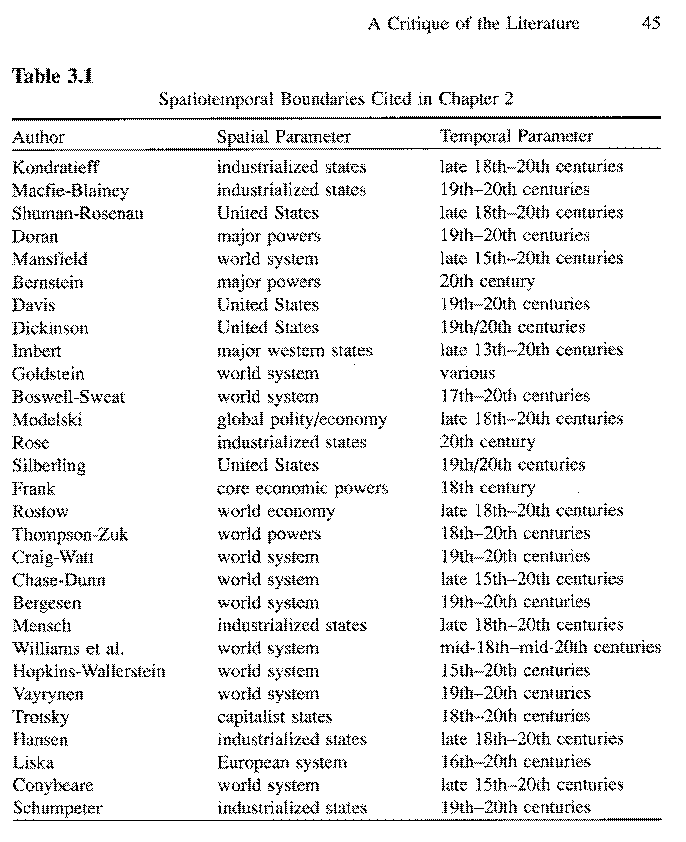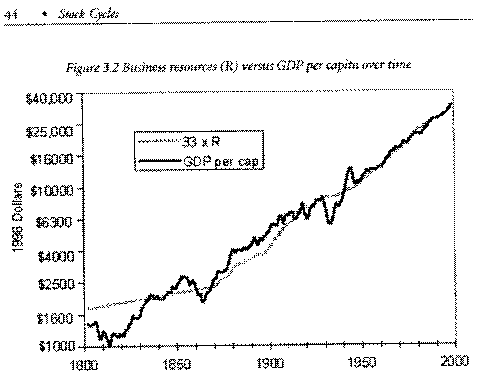Code:
Year Nominal Real GDP Popu- Nominal Real GDP
GDP GDP Defla- lation GDP per per
(billions (billions tor (in Capita Capita
of of 2000 (index millions) (current (2000
dollars) dollars) 2000 = dollars) dollars)
100)
------ ---------- --------- ------- --------- --------- --------
1789 $.210 $4.22 4.98 3.81 $55.10 $1,100
1790 $.240 $4.79 4.99 3.93 $60.80 $1,210
1791 $.250 $4.89 5.09 4.05 $61.40 $1,200
1792 $.270 $5.20 5.21 4.17 $64.90 $1,240
1793 $.300 $5.43 5.56 4.3 $70.20 $1,260
1794 $.350 $5.72 6.11 4.43 $78.80 $1,290
1795 $.420 $6.24 6.78 4.56 $92.70 $1,360
1796 $.470 $6.71 7.04 4.7 $100.00 $1,420
1797 $.450 $6.57 6.91 4.84 $93.80 $1,350
1798 $.460 $6.81 6.78 4.99 $92.50 $1,360
1799 $.500 $7.36 6.77 5.14 $96.80 $1,430
------ ---------- --------- ------- --------- --------- --------
1800 $.520 $7.57 6.86 5.31 $97.80 $1,420
1801 $.580 $8.62 6.76 5.49 $106.00 $1,560
1802 $.540 $7.94 6.76 5.68 $94.50 $1,390
1803 $.560 $8.43 6.64 5.87 $95.30 $1,430
1804 $.620 $8.86 6.96 6.07 $101.00 $1,460
1805 $.700 $9.55 7.28 6.26 $111.00 $1,520
1806 $.690 $9.38 7.40 6.45 $107.00 $1,450
1807 $.700 $9.87 7.05 6.64 $104.00 $1,480
1808 $.660 $9.30 7.09 6.84 $96.40 $1,350
1809 $.750 $10.37 7.21 7.03 $106.00 $1,470
------ ---------- --------- ------- --------- --------- --------
1810 $.810 $10.87 7.50 7.22 $112.00 $1,500
1811 $.810 $11.00 7.39 7.46 $109.00 $1,470
1812 $.830 $10.73 7.73 7.7 $107.00 $1,390
1813 $.970 $11.72 8.28 7.94 $122.00 $1,470
1814 $1.12 $12.60 8.87 8.18 $136.00 $1,540
1815 $1.15 $12.87 8.94 8.42 $136.00 $1,520
1816 $1.15 $13.26 8.67 8.66 $132.00 $1,530
1817 $1.15 $13.84 8.31 8.9 $129.00 $1,550
1818 $1.14 $15.07 7.60 9.1 $125.00 $1,650
1819 $1.00 $14.81 6.75 9.3 $107.00 $1,590
------ ---------- --------- ------- --------- --------- --------
1820 $.860 $14.86 5.77 9.6 $89.30 $1,540
1821 $.820 $15.05 5.47 9.9 $83.10 $1,520
1822 $.910 $17.09 5.32 10.27 $88.40 $1,660
1823 $.890 $16.66 5.36 10.6 $84.20 $1,570
1824 $.920 $16.90 5.42 10.92 $83.80 $1,540
1825 $1.04 $19.21 5.41 11.25 $92.40 $1,700
1826 $.990 $18.53 5.36 11.58 $85.70 $1,600
1827 $1.01 $19.39 5.19 11.91 $84.50 $1,620
1828 $1.05 $20.35 5.14 12.24 $85.40 $1,660
1829 $1.08 $21.00 5.13 12.57 $85.70 $1,670
------ ---------- --------- ------- --------- --------- --------
1830 $1.09 $21.41 5.07 12.9 $84.10 $1,660
1831 $1.16 $22.38 5.17 13.3 $87.00 $1,680
1832 $1.24 $23.80 5.23 13.7 $90.70 $1,730
1833 $1.34 $25.67 5.23 14.1 $95.10 $1,820
1834 $1.36 $27.39 4.96 14.5 $93.70 $1,880
1835 $1.60 $26.96 5.94 15 $106.00 $1,790
1836 $1.84 $26.88 6.85 15.42 $119.00 $1,740
1837 $1.80 $29.23 6.16 15.84 $113.00 $1,840
1838 $1.82 $29.41 6.17 16.26 $111.00 $1,800
1839 $1.95 $32.04 6.10 16.68 $117.00 $1,920
------ ---------- --------- ------- --------- --------- --------
1840 $1.73 $31.85 5.43 17.12 $101.00 $1,860
1841 $1.76 $32.92 5.35 17.73 $99.30 $1,850
1842 $1.64 $32.63 5.02 18.35 $89.20 $1,770
1843 $1.61 $36.18 4.46 18.96 $85.00 $1,900
1844 $1.73 $37.63 4.61 19.57 $88.60 $1,920
1845 $1.89 $39.07 4.84 20.18 $93.70 $1,930
1846 $2.01 $39.92 5.04 20.79 $96.80 $1,920
1847 $2.31 $43.82 5.27 21.41 $107.00 $2,040
1848 $2.13 $43.91 4.85 22.02 $96.60 $1,990
1849 $2.25 $44.07 5.10 22.63 $99.40 $1,940
------ ---------- --------- ------- --------- --------- --------
1850 $2.54 $47.33 5.36 23.26 $109.00 $2,030
1851 $2.61 $50.98 5.11 24.09 $108.00 $2,110
1852 $2.76 $57.01 4.85 24.91 $110.00 $2,280
1853 $3.15 $63.15 4.99 25.74 $122.00 $2,450
1854 $3.50 $61.03 5.74 26.56 $131.00 $2,290
1855 $3.87 $66.32 5.84 27.39 $141.00 $2,420
1856 $4.08 $67.35 6.06 28.21 $144.00 $2,380
1857 $4.47 $67.90 6.58 29.04 $153.00 $2,330
1858 $4.07 $72.91 5.58 29.86 $136.00 $2,440
1859 $4.40 $75.23 5.85 30.69 $143.00 $2,450
------ ---------- --------- ------- --------- --------- --------
1860 $4.49 $77.72 5.77 31.51 $142.00 $2,460
1861 $4.59 $76.52 6.00 32.35 $141.00 $2,360
1862 $5.24 $77.09 6.80 33.19 $157.00 $2,320
1863 $6.56 $77.53 8.46 34.03 $192.00 $2,270
1864 $9.27 $94.36 9.83 34.86 $266.00 $2,700
1865 $9.14 $86.57 10.50 35.7 $256.00 $2,420
1866 $8.88 $88.02 10.00 36.54 $243.00 $2,400
1867 $8.51 $89.02 9.56 37.38 $227.00 $2,380
1868 $8.49 $92.72 9.15 38.21 $222.00 $2,420
1869 $8.28 $96.93 8.54 39.5 $209.00 $2,450
------ ---------- --------- ------- --------- --------- --------
1870 $8.49 $104.40 8.13 39.91 $212.00 $2,610
1871 $8.77 $109.30 8.02 40.94 $214.00 $2,670
1872 $8.90 $113.80 7.82 41.97 $212.00 $2,710
1873 $9.27 $119.60 7.75 43.01 $215.00 $2,780
1874 $8.95 $118.90 7.52 44.04 $203.00 $2,700
1875 $9.02 $125.10 7.21 45.07 $200.00 $2,770
1876 $8.78 $126.60 6.93 46.11 $190.00 $2,740
1877 $8.91 $130.50 6.82 47.14 $189.00 $2,760
1878 $8.71 $135.90 6.41 48.17 $180.00 $2,820
1879 $9.49 $152.50 6.22 49.21 $192.00 $3,100
------ ---------- --------- ------- --------- --------- --------
1880 $11.14 $170.30 6.54 50.26 $221.00 $3,380
1881 $11.48 $176.50 6.50 51.54 $222.00 $3,420
1882 $12.45 $187.60 6.64 52.82 $235.00 $3,550
1883 $12.33 $192.20 6.41 54.1 $227.00 $3,550
1884 $12.01 $195.70 6.13 55.3 $217.00 $3,540
1885 $11.80 $197.20 5.98 56.6 $208.00 $3,480
1886 $12.15 $203.20 5.98 57.9 $209.00 $3,510
1887 $12.71 $212.40 5.98 59.2 $214.00 $3,580
1888 $12.86 $211.50 6.08 60.5 $212.00 $3,490
1889 $13.69 $224.70 6.09 61.7 $221.00 $3,640
------ ---------- --------- ------- --------- --------- --------
1890 $13.56 $228.10 5.94 63 $215.00 $3,620
1891 $13.99 $235.60 5.94 64.3 $217.00 $3,660
1892 $14.47 $246.70 5.86 65.6 $220.00 $3,760
1893 $14.51 $246.50 5.88 66.9 $216.00 $3,680
1894 $13.32 $239.10 5.57 68.2 $195.00 $3,500
1895 $14.66 $267.10 5.49 69.5 $210.00 $3,840
1896 $14.37 $261.00 5.50 70.8 $202.00 $3,680
1897 $15.31 $282.30 5.42 72.1 $212.00 $3,910
1898 $15.87 $289.00 5.49 73.4 $216.00 $3,930
1899 $17.97 $322.10 5.58 74.8 $240.00 $4,300
------ ---------- --------- ------- --------- --------- --------
1900 $18.68 $327.90 5.70 76.09 $245.00 $4,310
1901 $21.06 $367.70 5.73 77.58 $271.00 $4,730
1902 $21.73 $373.80 5.81 79.16 $274.00 $4,720
1903 $22.92 $384.30 5.96 80.63 $284.00 $4,760
1904 $24.00 $398.80 6.02 82.17 $292.00 $4,850
1905 $26.19 $435.20 6.02 83.82 $312.00 $5,190
1906 $28.16 $452.90 6.22 85.45 $329.00 $5,300
1907 $28.95 $445.90 6.49 87.01 $332.00 $5,120
1908 $26.79 $421.70 6.35 88.71 $302.00 $4,750
1909 $29.94 $470.60 6.36 90.49 $330.00 $5,200
------ ---------- --------- ------- --------- --------- --------
1910 $31.30 $472.70 6.62 92.41 $338.00 $5,110
1911 $32.24 $487.80 6.61 93.86 $343.00 $5,190
1912 $34.92 $515.90 6.77 95.34 $366.00 $5,410
1913 $36.63 $536.20 6.83 97.23 $376.00 $5,510
1914 $34.31 $495.40 6.93 99.11 $346.00 $4,990
1915 $36.30 $512.00 7.09 100.55 $361.00 $5,090
1916 $45.89 $594.40 7.72 101.96 $450.00 $5,820
1917 $54.85 $593.30 9.24 103.27 $531.00 $5,740
1918 $69.35 $638.60 10.80 103.21 $671.00 $6,180
1919 $76.63 $618.50 12.30 104.51 $733.00 $5,910
------ ---------- --------- ------- --------- --------- --------
1920 $86.76 $606.60 14.30 106.46 $814.00 $5,690
1921 $72.93 $585.70 12.40 108.54 $671.00 $5,390
1922 $72.43 $625.90 11.50 110.05 $658.00 $5,680
1923 $84.91 $713.00 11.90 111.95 $758.00 $6,360
1924 $87.29 $732.80 11.90 114.11 $764.00 $6,420
1925 $90.75 $748.60 12.10 115.83 $783.00 $6,460
1926 $96.77 $793.90 12.10 117.4 $824.00 $6,760
1927 $95.60 $798.40 11.90 119 $803.00 $6,700
1928 $96.52 $812.60 11.80 120.51 $800.00 $6,740
1929 $103.60 $865.20 11.97 121.77 $850.78 $7,105
------ ---------- --------- ------- --------- --------- --------
1930 $91.20 $790.70 11.53 123.08 $740.98 $6,424
1931 $76.50 $739.90 10.34 124.04 $616.74 $5,965
1932 $58.70 $643.70 9.12 124.84 $470.20 $5,156
1933 $56.40 $635.50 8.87 125.58 $449.12 $5,060
1934 $66.00 $704.20 9.37 126.37 $522.28 $5,572
1935 $73.30 $766.90 9.56 127.25 $576.03 $6,026
1936 $83.80 $866.60 9.67 128.05 $654.43 $6,767
1937 $91.90 $911.10 10.09 128.82 $713.40 $7,072
1938 $86.10 $879.70 9.79 129.82 $663.23 $6,776
1939 $92.20 $950.70 9.70 130.88 $704.46 $7,263
------ ---------- --------- ------- --------- --------- --------
1940 $101.40 $1,034 9.81 132.122 $767.47 $7,826
1941 $126.70 $1,211 10.46 133.402 $949.76 $9,078
1942 $161.90 $1,435 11.28 134.86 $1,200 $10,643
1943 $198.60 $1,670 11.89 136.739 $1,452 $12,219
1944 $219.80 $1,806 12.17 138.397 $1,588 $13,053
1945 $223.10 $1,786 12.49 139.928 $1,594 $12,765
1946 $222.30 $1,589 13.99 141.389 $1,572 $11,241
1947 $244.20 $1,574 15.51 144.126 $1,694 $10,924
1948 $269.20 $1,643 16.38 146.631 $1,835 $11,206
1949 $267.30 $1,634 16.35 149.188 $1,791 $10,956
------ ---------- --------- ------- --------- --------- --------
1950 $293.80 $1,777 16.53 152.271 $1,929 $11,671
1951 $339.30 $1,915 17.72 154.878 $2,190 $12,364
1952 $358.30 $1,988 18.02 157.553 $2,274 $12,619
1953 $379.40 $2,079 18.24 160.184 $2,368 $12,981
1954 $380.40 $2,065 18.42 163.026 $2,333 $12,669
1955 $414.80 $2,212 18.75 165.931 $2,499 $13,335
1956 $437.50 $2,255 19.39 168.903 $2,590 $13,355
1957 $461.10 $2,301 20.04 171.984 $2,681 $13,379
1958 $467.20 $2,279 20.50 174.882 $2,671 $13,032
1959 $506.60 $2,441 20.75 177.83 $2,848 $13,728
------ ---------- --------- ------- --------- --------- --------
1960 $526.40 $2,501 21.04 180.671 $2,913 $13,847
1961 $544.70 $2,560 21.28 183.691 $2,965 $13,936
1962 $585.60 $2,715 21.57 186.538 $3,139 $14,555
1963 $617.70 $2,834 21.80 189.242 $3,264 $14,975
1964 $663.60 $2,998 22.13 191.889 $3,458 $15,626
1965 $719.10 $3,191 22.53 194.303 $3,700 $16,423
1966 $787.80 $3,399 23.18 196.56 $4,007 $17,292
1967 $832.60 $3,484 23.89 198.712 $4,189 $17,535
1968 $910.00 $3,652 24.91 200.706 $4,533 $18,199
1969 $984.60 $3,765 26.15 202.677 $4,857 $18,578
------ ---------- --------- ------- --------- --------- --------
1970 $1,038 $3,771 27.53 205.052 $5,064 $18,394
1971 $1,127 $3,898 28.91 207.661 $5,427 $18,773
1972 $1,238 $4,105 30.17 209.896 $5,899 $19,557
1973 $1,382 $4,341 31.85 211.909 $6,524 $20,487
1974 $1,500 $4,319 34.73 213.854 $7,014 $20,198
1975 $1,638 $4,311 38.00 215.973 $7,585 $19,961
1976 $1,825 $4,540 40.20 218.035 $8,371 $20,826
1977 $2,030 $4,750 42.75 220.239 $9,221 $21,569
1978 $2,294 $5,015 45.76 222.585 $10,309 $22,530
1979 $2,563 $5,173 49.55 225.055 $11,389 $22,987
------ ---------- --------- ------- --------- --------- --------
1980 $2,789 $5,161 54.04 227.726 $12,249 $22,666
1981 $3,128 $5,291 59.12 229.966 $13,603 $23,010
1982 $3,255 $5,189 62.73 232.188 $14,018 $22,349
1983 $3,536 $5,423 65.21 234.307 $15,094 $23,148
1984 $3,933 $5,813 67.66 236.348 $16,641 $24,597
1985 $4,220 $6,053 69.71 238.466 $17,697 $25,386
1986 $4,462 $6,263 71.25 240.651 $18,544 $26,027
1987 $4,739 $6,475 73.20 242.804 $19,519 $26,668
1988 $5,103 $6,742 75.69 245.021 $20,830 $27,518
1989 $5,484 $6,981 78.56 247.342 $22,173 $28,225
------ ---------- --------- ------- --------- --------- --------
1990 $5,803 $7,112 81.59 250.132 $23,200 $28,434
1991 $5,995 $7,100 84.44 253.493 $23,653 $28,010
1992 $6,337 $7,336 86.38 256.894 $24,670 $28,558
1993 $6,657 $7,532 88.38 260.255 $25,580 $28,943
1994 $7,072 $7,835 90.26 263.436 $26,845 $29,743
1995 $7,397 $8,031 92.11 266.557 $27,752 $30,131
1996 $7,816 $8,328 93.85 269.667 $28,987 $30,885
1997 $8,304 $8,703 95.41 272.912 $30,428 $31,891
1998 $8,747 $9,066 96.47 276.115 $31,678 $32,837
1999 $9,268 $9,470 97.87 279.295 $33,184 $33,907
------ ---------- --------- ------- --------- --------- --------
2000 $9,817 $9,817 100.00 282.434 $34,758 $34,758
2001 $10,100 $9,866 102.37 285.545 $35,373 $34,553
2002 $10,480 $10,080 103.95 288.6 $36,316 $34,937
2003 $10,980 $10,390 105.64 290.5 $37,810 $35,790
Sincerely,


